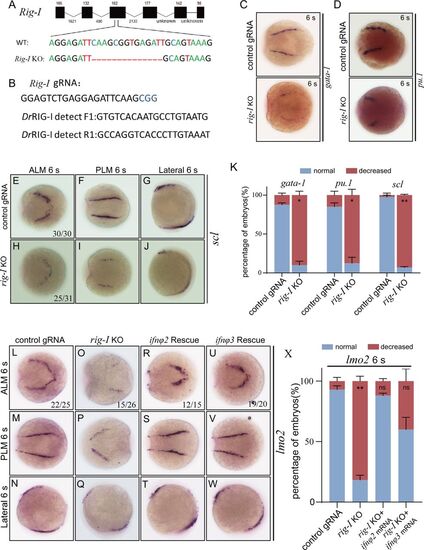Fig. 5
|
Detection of rig-I knockout in embryos and effect of rig-I knockout on the expression of hematopoietic precursor markers (A) Sequence of the third exon of rig-I showing target sites of gRNA, leading to the deletion of 14 bp. (B) Rig-I–gRNA sequence and primers used to detect CRISPR-Cas9–based rig-I knockout. (C–J) Expression of erythroid lineage marker gata-1, myeloid lineage marker pu.1/spi1, hematopoietic precursor marker scl/tal1, at the six-somite stage in rig-I−/− embryos, as detected by WISH. (K) Percent of embryos with phenotype of normal or decreased staining intensity in control or rig-I−/− embryos from (C)–(J) based on WISH analysis. (L–W) Expression of lmo2 at the six-somite stage in control embryos from dorsal view (L and M) and lateral view (N), rig-I−/− embryos from dorsal view (O and P) and lateral view (Q), and rig-I−/− embryos with ifnφ2 mRNA from dorsal view (R and S) and lateral view (T), or rig-I−/− embryos with ifnφ3 mRNA from dorsal view (U and V) and lateral view (W). (X) Percent of embryos with phenotype of normal or decreased staining intensity in control or rig-I morphant embryos from (L)–(W) based on WISH analysis. The number of embryos used in the experiment is shown in the figures. Images were captured under Olympus stereoscope (MVX10 MacroView; original magnification ×50). Each experiment was repeated three times (n = 3, mean ± SD, Student t test, *p < 0.05, **p < 0.01; ns, not significant). |
| Genes: | |
|---|---|
| Fish: | |
| Anatomical Terms: | |
| Stage: | 5-9 somites |
| Fish: | |
|---|---|
| Observed In: | |
| Stage: | 5-9 somites |

